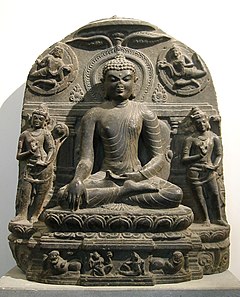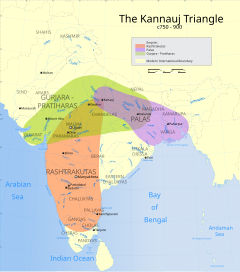Pala (dynasty)
The Pala dynasty was an Indian dynasty, which ruled the empire existing on the Indian subcontinent between about 750 and 1161 . She is known, among other things, for her promotion of Buddhism in Nalanda .
history
In the middle of the 8th century the power structure of North India was unstable (including interventions by Lalitaditya from Kashmir and the Tibetans ), it was the time of the "right of the fish" (matsyanyaya) . The population of Bengal around the year 750 elected the Buddhist Gopala (ruled approx. 750–775) as king, an outsider without a clear place of origin, who belonged neither to the Brahmin caste nor to the hereditary nobility.
The most powerful kings in the following period were Gopala's son Dharmapala (ruled approx. 775-810) and his son Devapala (ruled approx. 810-850) - both Buddhists - who united the Bengali and the Pala dynasty to one of the most important ruling families did in 9th century India. The foreign policy opponents of the Pala were the Pratihara and the Rashtrakuta . Dharmapala tried to establish a vassal king named Chakrayuda in Kannauj , but was defeated by the Pratihara at Monghyr in 807 and had to give up his ambitions. His son Devapala also wanted to expand his territory.
The succession of King Devapala turned out to be a problem: several aspirants to the throne appeared at the same time, and the reign of Vigrahapala (ruled approx. 850–854), who soon retired to a monastery, and the childish Narayanapala (ruled approx. 854–854) 908) ceded the throne. Under Narayanapala, mismanagement led to the decline of the Pala dynasty, whose positions have now been taken over by the Pratihara. Under Rajayapala (ruled 908-932) they only owned a few districts around Patna , while their vassals (Chandra, Varma, Kamboja) became practically independent.
A brief revival of the kingdom under Mahipala I (r. Approx. 992-1040) finally ended around 1022/23 in a lost war with the powerful southern Indian kingdom of the Chola . Mahipala's successors were then already vassals of the Kalachuri conqueror Karna (ruled approx. 1041-1072, tried to take over the inheritance of the Pratihara ) and equally threatened by enemies ( e.g. Chalukya Vikramaditya IV.) And rebellions (Varendra rebellion). In the 1180s, King Ramapala (ruled approx. 1082–1124) restored the Pala Empire, but his authority over the vassals remained shaken.
At the latest after Ramapala's death, the rise of the Sena dynasty took place in Bengal under its king Vijayasena (ruled approx. 1097–1159), who drove the Pala out of the country, while in Monghyr (= Munger , Bihar) around 1146 the Gahadavala Govindachandra (reg. approx. 1114–1155) is mentioned. Vijayasena's successor Ballalasena (ruled approx. 1159–1185) finally destroyed the Pala in Bihar around 1161.
Religion and culture
In the land of the Pala dynasty, Buddhism and native tantric mother goddess cults prospered . As a result, the norms of the caste system were only implemented to a limited extent in the population of Bengal for a long time. Dealing with outcasts and prostitutes was partially seen as beneficial and necessary. Buddhism (in the Vajrajana form) persisted in Bengal after it had long been ousted by Hinduism in the rest of India, and from there spread to Tibet (including the reformer Atisha in the early 11th century), Burma and Indonesia . At the same time painting and plastic art were passed on. The well-known universities of the time were Nalanda , Vikramashila (founded by King Dharmapala) and Ottantapuri. It was not until the late Pala - although still oriented towards the coexistence of Buddhism and Hinduism - that Hinduism gained greater influence.
The Pala have left no spectacular monuments, only the ruins of Nalanda and an abundance of Buddhist and Hindu stone sculptures testify to the skill of the builders and stonemasons of the time.
economy
Despite the great distances, there were significant trade links with the island of Java and other regions in Southeast Asia. As a result of the mutually profitable maritime trade that Bengal conducted with the Arab world during the Pala period , the dynasty was also mentioned by Arab chroniclers.
List of the great kings
- Gopala I. (founder of the dynasty around 750, unsecured period of rule)
- Dharmapala, son of Gopala I (35 years old) (775–810)
- Devapala, son of Dharmapala (35 or 39 years old) (810–850)
- Vigrahapala I., great-grandson v. Golpala I. (unsecured reg. Duration) (850-854)
- Narayanapala, son of Vigrahapala (54 years) (854–908)
- Rajyapala, son of Narayanapala (37 years)
- Gopala III., Son of Rajyapala (11 or 17 years)
- Vigrahapala II., Son of Gopala III. (unsecured reg. duration)
- Mahipala I, son of Vigrahapala II (48 years)
- Nayapala, son of Mahipala (15 years)
- Vigrahapala III., Son of Nayapala (26 years)
- Mahipala II, son of Vigrahapala III. (unsecured reg. duration)
- Shurapala, son of Vigrahapala III. (unsecured reg. duration)
- Ramapala, son of Vigrahapala III. (53 years)
- Kumarapala, son of Ramapala (unsecured period of rule)
- Gopala IV., Son of Kumarapala (15 years)
- Madanapala, son of Ramapala, brother of Kumarapala (approx. 1143 – approx. 1165)
- Palapala (undated) and Govindrapala (around 1176)
literature
- Jhunu Bagchi: The History and Culture of the Pālas of Bengal and Bihar, Cir. 750 AD – cir. 1200 AD Abhinav Publications 1993, ISBN 978-81-7017-301-4
- Susan L. Huntington: The "Påala-Sena" Schools of Sculpture. Brill Archive 1984, ISBN 90-04-06856-2 .
Web links
- Pala Dynasty (Banglapedia, English)
- Pala rule (Banglapedia, English)
- Ramapala, the last important Pala (Banglapedia, English)


